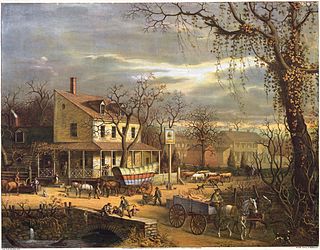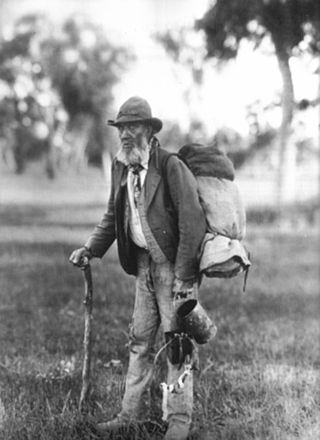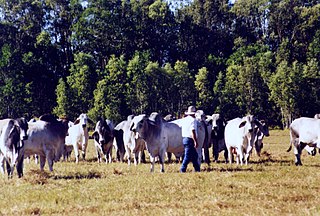
The Outback is a remote, vast, sparsely populated area of Australia. The Outback is more remote than the bush. While often envisaged as being arid, the Outback regions extend from the northern to southern Australian coastlines and encompass a number of climatic zones, including tropical and monsoonal climates in northern areas, arid areas in the "red centre" and semi-arid and temperate climates in southerly regions.

Inns are generally establishments or buildings where travelers can seek lodging, and usually, food and drink. Inns are typically located in the country or along a highway. Before the advent of motorized transportation, they also provided accommodation for horses.

"Waltzing Matilda" is a song developed in the Australian style of poetry and folk music called a bush ballad. It has been described as the country's "unofficial national anthem".

A swagman was a transient labourer who travelled by foot from farm to farm carrying his belongings in a swag. The term originated in Australia in the 19th century and was later used in New Zealand.

Lebkuchen, Honigkuchen or Pfefferkuchen, are honey-sweetened German cakes molded cookie or bar cookie that have become part of Germany's Christmas traditions. They are similar to gingerbread.

A flapjack is a baked bar, cooked in a flat oven tin and cut into squares or rectangles, made from rolled oats, fat, brown sugar and usually golden syrup.

In Australia, a swag is a portable sleeping unit. It is normally a bundle of belongings rolled in a traditional fashion to be carried by a foot traveller in the bush. Before motor transport was common, foot travel over long distances was essential to agriculture in the Australian bush. It is sometimes referred to as a "backpack bed". Swags have been carried by shearers, miners, the unemployed, and many others, some of whom would have been happy to have been called swagmen and some not.

A lunch box refers to a hand-held container used to transport food, usually to work or to school. It is commonly made of metal or plastic, is reasonably airtight and often has a handle for carrying.

A big-box store is a physically large retail establishment, usually part of a chain of stores. The term sometimes also refers, by extension, to the company that operates the store. The term "big-box" references the typical appearance of buildings occupied by such stores.

In Australia a stockman is a person who looks after the livestock on a large property known as a station, which is owned by a grazier or a grazing company, traditionally on horse. In this sense it has a similar meaning to "cowboy". A stockman may also be employed at an abattoir, feedlot, on a livestock export ship, or with a stock and station agency.

Leftovers are surplus foods remaining unconsumed at the end of a meal, which may be put in containers with the intention of eating later. Inedible remains like bones are considered waste, not leftovers. Depending on the situation, the amount of food, and the type of food, leftovers may be saved or thrown away.

Bush tucker, also called bush food, is any food native to Australia and used as sustenance by Indigenous Australians, the Aboriginal and Torres Strait Islander peoples, but it can also describe any native flora or fauna used for culinary or medicinal purposes, regardless of the continent or culture. Animal native foods include kangaroo, emu, witchetty grubs and crocodile, and plant foods include fruits such as quandong, kutjera, spices such as lemon myrtle and vegetables such as warrigal greens and various native yams.

Romanichals are a Romani subgroup within the United Kingdom and other parts of the English-speaking world. There are an estimated 500,000 Romani in the United Kingdom; almost all live in England. Most Romanichal speak Angloromani, a mixed language that blends Romani vocabulary with English syntax.

A tuck shop is a small retailer located either within or close-to the grounds of a school, hospital, apartment complex, or other similar facility. In traditional British usage, tuck shops are associated chiefly with the sale of confectionery, sweets, or snacks and are common at private ('fee-paying') schools. Tuck shops located within a campus are often the only place where monetary transactions may be made by students. As such, they may also sell items of stationery or other related school items. In some regions, the words 'tuck shop' may be interchangeable with a 'canteen'. The term is used in the UK, Ireland, Australia, New Zealand, South Africa, Canada, Nigeria, Pakistan, India, Jamaica, Hong Kong, Botswana, The Bahamas and in other parts of the former British Empire.

A dillybag or dilly bag is a traditional Australian Aboriginal bag generally woven from plant fibres. Dillybags are mainly designed and used by women to gather and transport food, and are most commonly found in the northern parts of Australia.

A bag is a common tool in the form of a non-rigid container. The use of bags predates recorded history, with the earliest bags being lengths of animal skin, cotton, or woven plant fibers, folded up at the edges and secured in that shape with strings of the same material.

A container is any receptacle or enclosure for holding a product used in storage, packaging, and transportation, including shipping. Things kept inside of a container are protected on several sides by being inside of its structure. The term is most frequently applied to devices made from materials that are durable and are often partly or completely rigid.

Paximathia, also spelt paximadia (plural), or paximadi/paximathi (singular), is a hard bread of Greek origin, similar to rusk, that is prepared with whole wheat, chick pea or barley flour. It has been referred to as being similar to biscotti or as a type of biscotti. Paximathia is a common food in Greece and many Greek bakeries sell the bread, which is often served as a breakfast food with marmalade or cheese. Paximathia is purveyed also in Greek specialty stores in many areas of the United States.

A hat box is a container for storing and transporting headgear, protecting it from damage and dust. A more generic term for a box used to carry garments, including headgear, is a bandbox. Typically, a hat box is deep and round in shape, although it may also be boxlike and used as an item of luggage for transporting a variety of hats.

A meal is an eating occasion that takes place at a certain time and includes consumption of food. The names used for specific meals in English vary, depending on the speaker's culture, the time of day, or the size of the meal.




















